Did you know that over 3.8 million people converted to Christianity annually in the early 2000s? This staggering number highlights the religion’s global influence and enduring legacy. From its humble beginnings to becoming one of the world’s largest faiths, the story of Christianity is filled with dramatic narratives of conversion and resistance.
Throughout history, the church has played a pivotal role in shaping societies. Early Christian communities faced persecution, yet their message of hope and salvation continued to spread. Over time, Christianity evolved from a persecuted sect to a dominant faith, influencing cultures and civilizations across the globe.
This section explores the historical context of Christianity’s growth, highlighting key turning points and the challenges it faced. From ancient Rome to modern-day Asia, the journey of this faith is a testament to its resilience and adaptability.
Key Takeaways
- Christianity has over two billion adherents worldwide.
- Conversion and resistance have shaped its historical narrative.
- The church played a central role in societal transformation.
- Early Christians faced persecution but continued to grow.
- Christianity’s influence spans cultures and continents.
Origins and Roots of Christianity
In the 1st century CE, a new religious identity began to take shape within ancient Jewish traditions. This movement, centered around the teachings of Jesus of Nazareth, laid the foundation for what would become one of the world’s most influential faiths. His message of love, forgiveness, and salvation resonated deeply with many, sparking a transformative shift in religious thought.

During this pivotal century, early followers blended Jewish customs with new beliefs, creating a unique spiritual path. The teachings of Christ emphasized a personal relationship with God, challenging traditional norms and inspiring a growing community of believers. This period marked the beginning of a faith that would eventually spread across continents.
“The kingdom of God is within you.” – A teaching that reflects the core of early beliefs.
Key historical moments in the 1st century played a crucial role in shaping this movement. From the crucifixion of Jesus to the missionary journeys of his disciples, these events solidified its identity and purpose. By the end of the century, small communities of believers had formed, setting the stage for future growth.
Understanding these early roots helps us appreciate how this faith evolved from a small Jewish sect into a global religion. Its ability to adapt and grow while staying true to its core teachings is a testament to its enduring legacy.
The Historical Emergence of Christianity
The convergence of Jewish and Roman cultures laid the groundwork for the emergence of a new faith. Early teachings were deeply rooted in Jewish traditions, blending ancient customs with transformative ideas. At the same time, Roman societal structures and Hellenistic thought provided a framework for its growth.
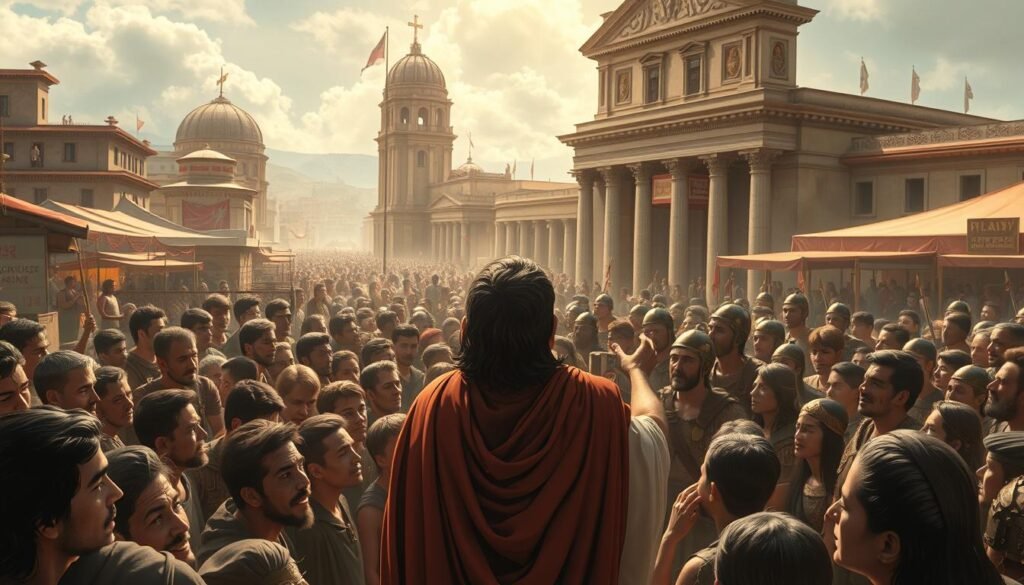
Jewish Influences and Ancient Traditions
Jewish traditions played a central role in shaping early beliefs. The teachings of Jesus emphasized a personal connection with God, drawing from Jewish scriptures and practices. The Pharisees and Sadducees, two prominent Jewish sects, influenced the doctrinal development of this movement.
Key events, such as the Maccabean Revolt and the destruction of the Temple, also shaped its early identity. These historical moments created a fertile ground for new interpretations of faith, blending Jewish customs with innovative spiritual ideas.
Roman and Hellenistic Impact
The Roman Empire’s governance and Hellenistic culture significantly influenced the spread of this faith. The Pax Romana, a period of relative peace, allowed for easier travel and communication among early followers. This facilitated the growth of small communities across the empire.
Hellenistic thought introduced philosophical concepts that enriched its teachings. The integration of Greek ideas with Jewish traditions created a unique spiritual path. This blend of cultures helped the faith adapt and thrive in diverse societies.
“The kingdom of God is within you.” – A teaching that reflects the core of early beliefs.
By the 4th century, the faith had become a dominant force, shaped by both Jewish roots and Roman influence. This historical journey highlights its ability to evolve while staying true to its foundational principles.
The Introduction of Christianity in the Philippines
The Philippines, a nation rich in culture and tradition, became a focal point for religious transformation in the 16th century. European missionaries arrived in 1521, introducing a new faith that would profoundly shape the country’s identity. This marked the beginning of a unique blend of foreign and local spiritual practices.
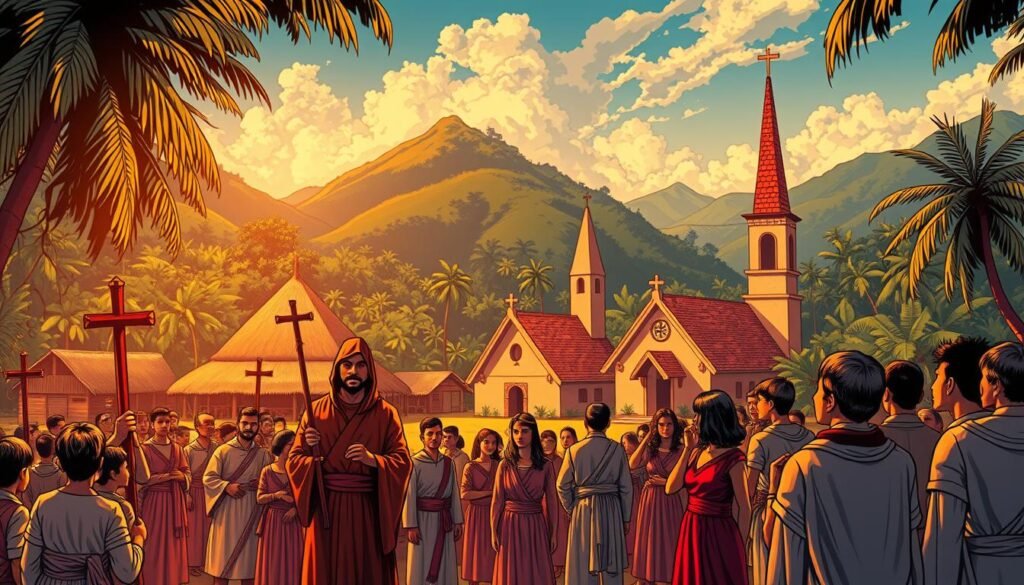
The arrival of Ferdinand Magellan and his crew in Cebu initiated the spread of Catholicism. Over 800 locals were baptized en masse, symbolizing the start of a religious evolution. This event laid the foundation for the integration of Christian teachings into Filipino society.
Spanish colonization, beginning in 1565, further solidified the presence of this faith. Missionaries played a crucial role in establishing churches and schools, fostering a deep connection between religion and daily life. The Catholic Church became a central institution, influencing both spiritual and societal norms.
Filipino culture adapted these teachings, creating a distinct form of worship. Festivals like Sinulog in Cebu celebrate this fusion, attracting millions annually. The reinterpretation of Christian practices within a local context highlights the resilience and creativity of Filipino spirituality.
| Year | Event | Impact |
|---|---|---|
| 1521 | Arrival of Magellan | First mass baptisms in Cebu |
| 1565 | Spanish colonization begins | Establishment of churches and schools |
| 2021 | 500th anniversary of Christianity | Nationwide celebrations and reflections |
Today, the Philippines remains one of the largest Catholic nations in the world. The introduction of this faith not only transformed its spiritual landscape but also strengthened its cultural identity. This historical journey underscores the enduring legacy of religious adaptation and synthesis.
Cultural Transformation and Religious Resistance
The interplay between cultural change and religious resistance has shaped societies. Throughout history, the introduction of new beliefs often clashed with established traditions. This tension has led to periods of profound transformation and fierce resistance.
One notable example is the spread of the new testament teachings during the Roman Empire. As the state sought to consolidate power, it often imposed religious practices on local populations. This led to resistance from communities that valued their traditional customs.
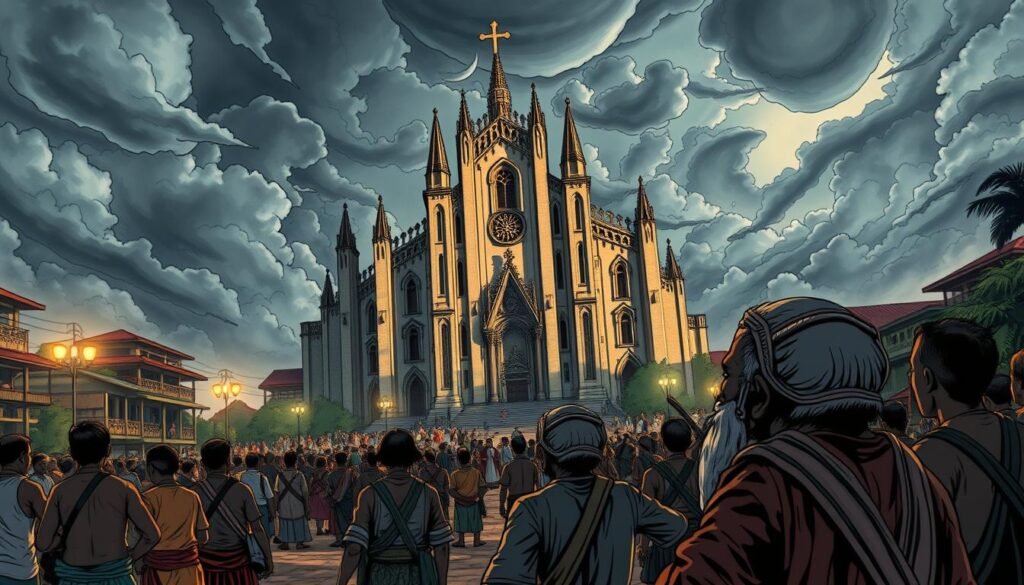
In many cases, the catholic church played a dual role. It acted as a unifying force while also facing pushback from those who saw it as an extension of foreign influence. This dynamic is evident in regions like the Philippines, where local practices blended with introduced beliefs.
“Resistance is not just opposition; it is the preservation of identity.”
Historical records show that state-imposed religious changes often sparked movements of defiance. For instance, during the Reformation, many communities resisted the centralized authority of the church. They sought to return to what they saw as the core teachings of the new testament.
These conflicts highlight the complex relationship between cultural evolution and religious identity. They remind us that faith is deeply intertwined with the social and political fabric of a society.
| Period | Event | Outcome |
|---|---|---|
| 4th Century | Roman adoption of Christianity | State-imposed religious practices |
| 16th Century | Reformation in Europe | Resistance to church authority |
| 19th Century | Missionary activity in Asia | Blending of local and foreign beliefs |
Today, the legacy of these struggles continues to influence how communities navigate cultural and religious change. The lessons of the past remind us of the resilience of faith and the importance of preserving identity in the face of transformation.
Key Figures in Early Christianity
The early spread of faith was driven by remarkable individuals who left an indelible mark on history. These pioneers not only shaped the beliefs of their time but also laid the groundwork for future generations. Their life stories and teachings continue to inspire millions around the world.
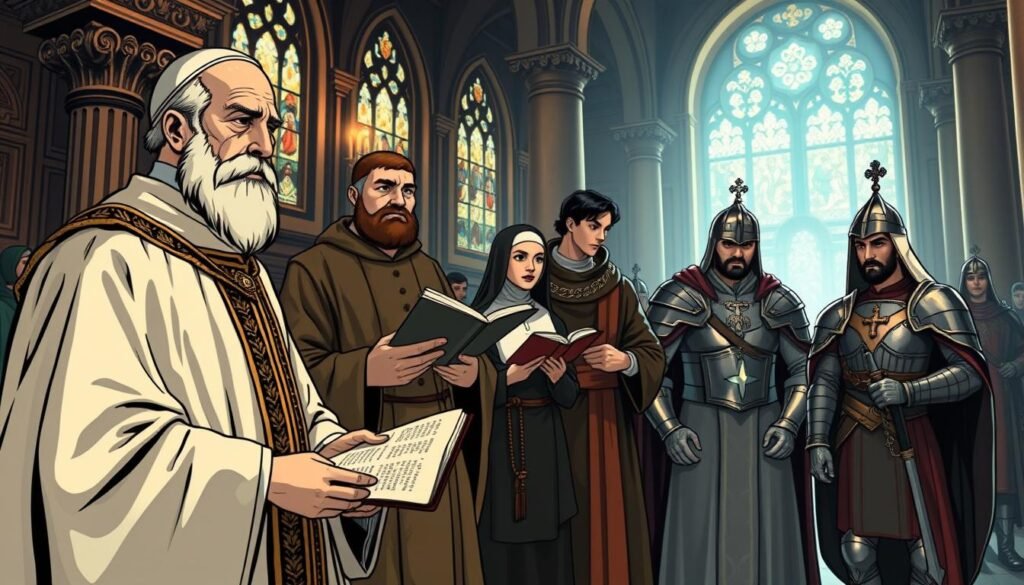
St. Paul the Apostle and His Mission
St. Paul, originally a persecutor of the faith, underwent a transformative conversion. His journey from opposition to devotion is one of the most compelling narratives in catholic history. After his conversion, Paul became a tireless missionary, spreading the message across the Roman Empire.
His letters, known as the Pauline epistles, are foundational to catholic doctrine. They address key aspects of faith, life, and community. Paul’s emphasis on grace and salvation reshaped early teachings, influencing both theology and practice.
“For I am not ashamed of the gospel, because it is the power of God that brings salvation to everyone who believes.” – St. Paul
Influential Thinkers and Reformers
Beyond St. Paul, other figures played crucial roles in shaping early faith. Augustine of Hippo, for instance, emphasized the importance of grace in personal transformation. His works remain central to catholic theology, blending intellectual rigor with spiritual depth.
Martin Luther, though later in history, challenged established norms with his doctrine of justification by faith alone. His reforms sparked a movement that redefined teachings and practices. These thinkers not only preserved the faith but also adapted it to new contexts.
| Figure | Contribution | Impact |
|---|---|---|
| St. Paul | Missionary journeys and epistles | Spread of faith across the Roman Empire |
| Augustine | Theology of grace | Shaped catholic doctrine |
| Martin Luther | Reformation principles | Redefined teachings and practices |
These key figures exemplify the resilience and adaptability of faith. Their contributions continue to influence the life and teachings of believers worldwide. Their legacy is a testament to the enduring power of spiritual leadership.
The Essence and Identity of the Christian Faith
At the heart of this faith lies a unique blend of tradition and transformation. Its identity is deeply rooted in the teachings of Jesus Christ, which have shaped its core beliefs and practices over centuries. This section explores how law, tradition, and human experience intertwine to define this faith’s essence.

One of the most significant aspects of this faith is its reinterpretation of law. Inherited from Jewish culture, the concept of law was transformed to emphasize grace and spiritual fulfillment. This shift marked a departure from rigid legalism, focusing instead on a personal relationship with the divine.
Tradition plays a vital role in preserving the faith’s identity. From ancient rituals to modern practices, these customs connect believers to their spiritual heritage. They serve as a bridge between the past and present, ensuring continuity while allowing for adaptation.
“The essence of faith is not in rules but in the heart’s transformation.”
The concept of what it means to be a man of faith has also evolved. Early teachings emphasized humility, service, and devotion, values that remain central today. This focus on character and integrity reflects the faith’s commitment to personal and communal growth.
Human experience and divine intervention are deeply intertwined in this faith. Stories of miracles, answered prayers, and spiritual renewal highlight the belief in a living, active presence. These narratives inspire believers to live out their faith in meaningful ways.
Over time, this faith has adapted to diverse cultures and contexts. Its ability to remain relevant while staying true to its core principles is a testament to its enduring legacy. Whether through law, tradition, or personal transformation, the essence of this faith continues to inspire millions worldwide.
Church Development and Institutional Hierarchy
The structure of the church evolved from informal gatherings to a highly organized institution. Early communities were loosely connected, but over time, a formal hierarchy emerged. This transformation was driven by the need to unify doctrine and practice across diverse regions.
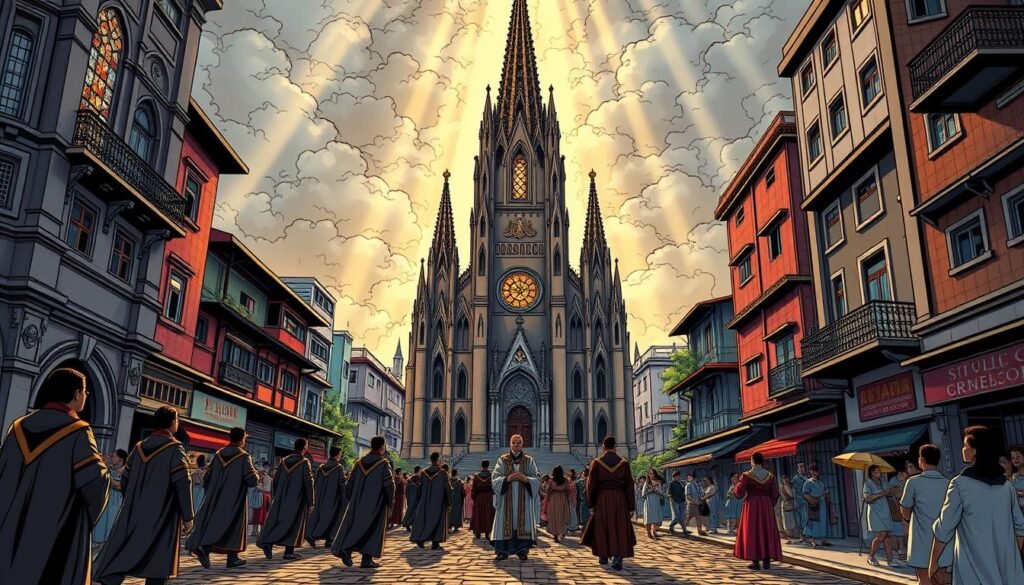
The Roman Catholic Church played a pivotal role in this process. It became the central institution for organizing religious thought and governance. Key developments, such as the establishment of episcopal orders and canonical law, solidified its authority.
The Role of the Roman Catholic Church
The church’s hierarchy was built on the foundation of apostolic succession. This concept traces leadership back to the original apostles, ensuring continuity and legitimacy. The idea of divine authority was central to this structure, as bishops were seen as successors to the apostles.
Doctrinal debates also shaped the church’s growth. Early councils, like the Council of Nicaea, addressed critical issues and established unified teachings. These gatherings reinforced the church’s role as the guardian of the testament of faith.
“The church is the pillar and foundation of truth.” – A reflection of its role in preserving doctrine.
By the Middle Ages, the church had developed a complex legal system. Canonical law governed everything from sacraments to property disputes. This legal framework ensured consistency and order within the institution.
- Episcopal orders established clear leadership roles.
- Canonical law provided a structured legal system.
- Apostolic succession linked leaders to the original apostles.
Today, the legacy of this hierarchical structure continues to influence religious governance. The church’s ability to adapt while maintaining its core principles is a testament to its enduring impact.
Understanding Christianity: Beliefs, Miracles, and Teachings
Miracles have long been a cornerstone of spiritual narratives, shaping the beliefs of millions. These extraordinary events, often described in biblical accounts, highlight the divine power of Jesus and his role in inspiring faith. From healing the sick to raising the dead, these acts continue to resonate deeply with believers worldwide.

Miracles, Resurrection, and the Role of Jesus
The Gospels recount numerous miracles performed by Jesus, each with profound theological significance. For instance, the healing of the blind and the feeding of the 5,000 demonstrate his compassion and divine authority. These acts not only addressed physical needs but also symbolized spiritual renewal.
One of the most pivotal events is the resurrection of Jesus. This miracle is central to the faith, symbolizing victory over death and the promise of eternal life. As stated in the Bible, “He is not here; he has risen!” (Luke 24:6). This event continues to inspire hope and belief in the power of divine intervention.
“For God so loved the world that he gave his one and only Son, that whoever believes in him shall not perish but have eternal life.” – John 3:16
Jesus’ teachings, such as the Sermon on the Mount, further emphasize the values of love, mercy, and humility. These principles guide the lives of believers, shaping their spiritual identity and community practices.
| Miracle | Biblical Reference | Significance |
|---|---|---|
| Healing the Blind | John 9:1-12 | Demonstrates divine compassion and power |
| Feeding the 5,000 | Matthew 14:13-21 | Symbolizes spiritual nourishment |
| Resurrection | Luke 24:1-12 | Represents victory over death |
These miracles and teachings underscore the enduring legacy of Jesus as a transformative person in history. They continue to inspire millions, reinforcing the core beliefs that define this spiritual path.
Analysis of Biblical Literature and Scripture
The Bible stands as one of the most influential texts in human history, shaping cultures and beliefs across millennia. Its pages contain a rich blend of narratives, laws, and teachings that have inspired countless generations. This section delves into the literary and theological depth of biblical scripture, examining its composition, themes, and enduring relevance.
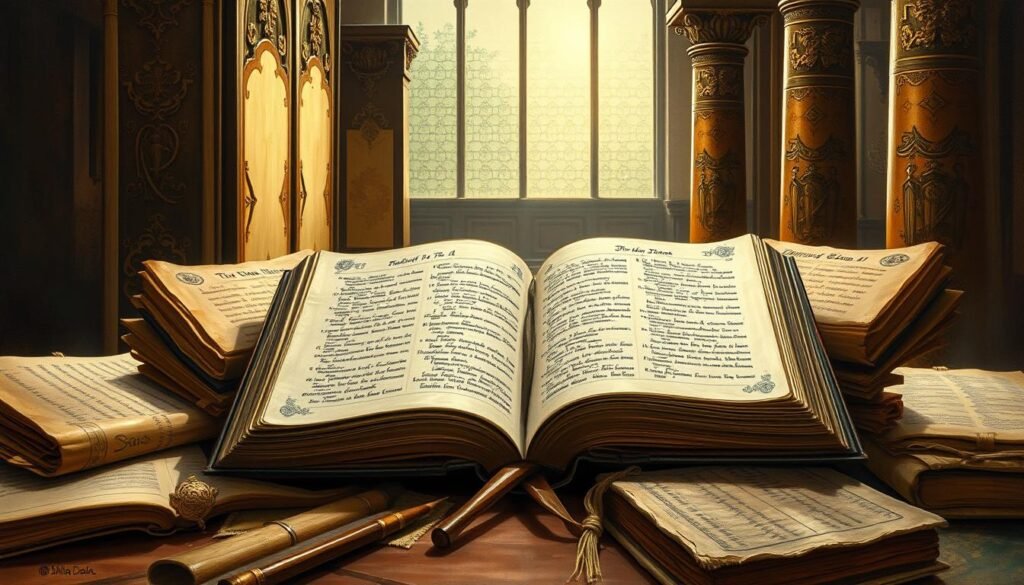
The Old Testament and Jewish Scriptures
The Old Testament, rooted in Jewish tradition, lays the foundation for biblical thought. It includes historical accounts, poetic writings, and prophetic messages. Key themes like the covenant between God and His people are central to its narrative. The destruction of the Temple in 70 CE marked a turning point, shifting focus from sacrificial worship to spiritual reflection.
Hebrew poetry, such as the Psalms, uses parallelism to convey profound truths. For example, Psalm 18:31–34 highlights God’s strength and protection. These texts not only shaped Jewish identity but also influenced early Christian teachings.
The New Testament and the Gospels
The New Testament introduces the life and teachings of Jesus, offering a transformative perspective on faith. The Gospels—Matthew, Mark, Luke, and John—provide unique accounts of His ministry, miracles, and resurrection. These narratives emphasize love, forgiveness, and salvation, reshaping the understanding of divine grace.
Paul, a pivotal figure, played a crucial role in spreading these teachings. His letters, or epistles, address theological questions and guide early Christian communities. For instance, Romans 8:38–39 underscores the inseparable bond between believers and God’s love.
“All Scripture is God-breathed and is useful for teaching, rebuking, correcting, and training in righteousness.” – 2 Timothy 3:16
The concept of “holy” evolves throughout the Bible. In the Old Testament, it often refers to ritual purity. In the New Testament, it signifies spiritual sanctity and moral integrity. This shift reflects the dynamic nature of biblical interpretation.
| Testament | Key Themes | Notable Figures |
|---|---|---|
| Old Testament | Covenant, Law, Prophecy | Moses, David, Isaiah |
| New Testament | Grace, Salvation, Love | Jesus, Paul, Peter |
Understanding biblical literature requires careful study of its historical and cultural context. For those interested in exploring this further, consider this biblical literature study. The Bible remains a timeless source of wisdom, offering insights into faith, humanity, and the divine.
The Reformation and the Birth of Protestantism
Martin Luther’s bold actions in 1517 sparked a movement that reshaped Europe’s spiritual landscape. His Ninety-five Theses challenged the Catholic Church’s practices, calling for a return to biblical teachings. This marked the beginning of the Protestant Reformation, a period of profound religious and social change.
The Reformation was driven by a renewed focus on the Old Testament and earlier scriptural interpretations. Reformers like Luther and John Calvin emphasized the Bible as the sole authority, rejecting the church’s traditional practices. This shift led to the end of many long-standing customs and the birth of new doctrines.
Key moments, such as Luther’s excommunication and the Diet of Worms, highlighted the growing divide. The Protestant Reformation not only transformed religious beliefs but also influenced politics and culture across Europe. For a deeper understanding of this pivotal period, explore the Protestant Reformation.
“Here I stand; I can do no other. God help me. Amen.” – Martin Luther at the Diet of Worms
The Reformation’s impact extended beyond theology. It encouraged literacy, as people sought to read the Bible for themselves. This movement also paved the way for religious freedoms, challenging the Catholic Church’s dominance.
| Event | Year | Significance |
|---|---|---|
| Posting of the Ninety-five Theses | 1517 | Marked the start of the Reformation |
| Diet of Worms | 1521 | Luther’s defiance and excommunication |
| Peace of Augsburg | 1555 | Allowed rulers to choose their region’s religion |
By the end of the 16th century, Protestantism had become a major force in Europe. Its emphasis on individual faith and scriptural authority continues to shape modern religious practices. The Reformation remains a testament to the power of ideas and the courage to challenge the status quo.
The Crusades and Their Impact on Christian Identity
The Crusades, spanning over two centuries, reshaped the spiritual and political landscape of medieval Europe and the Middle East. These holy wars were not just military campaigns but also a defining part of Christian identity. They were driven by the idea of reclaiming the Holy Land, a mission seen as divinely sanctioned.
From 1096 to 1300 CE, eight major Crusades took place, alongside smaller expeditions. These conflicts were deeply rooted in the belief that Jerusalem, the heart of the kingdom of God, must be liberated from Muslim control. This idea united knights, nobles, and commoners under a shared religious purpose.
Holy Wars and Religious Conflict
The Crusades were marked by intense religious fervor and ideological battles. The idea of a holy war became a central theme, blending territorial ambitions with spiritual goals. Crusaders saw themselves as soldiers of Christ, fighting for the kingdom of heaven.
However, these conflicts also led to significant religious tensions. The rift between the Western Roman Catholic and Eastern Orthodox Churches deepened, becoming a lasting part of Christian history. The Fourth Crusade’s attack on Constantinople in 1204 highlighted this division.
“The Crusades were not just about land; they were about the soul of Christendom.”
The long-term impact of the Crusades extended beyond the battlefield. They influenced the development of military orders like the Knights Templar and Hospitallers, which became a part of European society. These orders combined religious devotion with military discipline, embodying the idea of a warrior monk.
Economically, the Crusades spurred trade and cultural exchange. Cities like Venice and Genoa prospered, and new goods and knowledge flowed into Europe. This exchange was a crucial part of the groundwork for the Renaissance.
| Event | Year | Impact |
|---|---|---|
| First Crusade | 1096-1099 | Capture of Jerusalem |
| Fourth Crusade | 1202-1204 | Sack of Constantinople |
| Children’s Crusade | 1212 | Symbolic but tragic expedition |
Today, the legacy of the Crusades remains complex. They are a part of both Christian and Muslim historical memory, shaping perceptions of religious conflict. For a deeper understanding of their consequences, explore this detailed analysis.
The Crusades were more than just wars; they were a defining part of the Christian kingdom’s history. Their influence on faith, culture, and geopolitics continues to be felt, reminding us of the enduring power of ideas and beliefs.
Christianity and Political Transformation
The relationship between faith and governance has shaped civilizations for centuries. From ancient empires to modern democracies, religious values have influenced political structures and legal systems. This interplay has left a lasting legacy, redefining how societies are governed.
One of the most significant contributions of Christianity to politics is the concept of moral authority. Leaders often sought legitimacy by aligning themselves with religious principles. Figures like Constantine the Great, often referred to as the father of Christian Rome, used faith to unify their empires. This fusion of spiritual and political power became a cornerstone of governance.
The metaphorical death of old regimes often paved the way for new political orders. For instance, the fall of the Roman Empire saw the rise of medieval kingdoms, where the church played a central role in governance. The Papal States in Europe exemplified this blend of religious and political authority.
Critical events, such as the Reformation, further redefined the relationship between church and state. Martin Luther’s challenge to the Catholic Church led to the emergence of Protestantism, which emphasized individual faith over institutional control. This shift influenced the development of modern democracies, where religious freedom became a fundamental right.
“Render unto Caesar the things that are Caesar’s, and unto God the things that are God’s.” – A teaching that highlights the balance between faith and governance.
In the Philippines, the introduction of Christianity during Spanish colonization shaped its political landscape. The church became a central institution, influencing both spiritual and societal norms. Today, the country remains one of the largest Catholic nations, reflecting the enduring impact of this transformation.
Understanding this historical journey helps us appreciate the role of faith in shaping governance. As Christians navigate the complexities of modern politics, they are reminded of their dual citizenship in the kingdom of God and the kingdom of man. For more insights on this balance, explore this detailed analysis.
The Role of Missionaries and Evangelism
From the bustling streets of ancient cities to remote villages, missionaries have carried the message of hope and redemption across the globe. Their work has shaped cultures, transformed lives, and spread the teachings of the scripture to every corner of the world. This section explores the enduring legacy of missionary efforts, focusing on the challenges and triumphs of global evangelism.
Paul’s Legacy and Global Outreach
St. Paul stands as one of the most influential figures in the history of evangelism. His journeys across the Roman Empire brought the message of the kingdom of God to diverse communities. Paul’s letters, a cornerstone of the scripture, addressed themes of sin, grace, and redemption, shaping the foundation of Christian doctrine.
Paul’s approach to evangelism was both strategic and personal. He adapted his message to resonate with different cultures, emphasizing the universal nature of God’s love. His teachings on overcoming sin through faith continue to inspire missionaries today.
“For I am not ashamed of the gospel, because it is the power of God that brings salvation to everyone who believes.” – St. Paul
Missionaries have faced numerous challenges, from cultural barriers to persecution. Yet, their dedication to spreading the scripture has led to profound transformations. In the Philippines, for example, the arrival of Spanish missionaries in the 16th century introduced the concept of the kingdom of God, blending it with local traditions to create a unique spiritual identity.
Modern missionaries continue this legacy, addressing issues like poverty and education while sharing the message of hope. Their work reflects the core values of the scripture, emphasizing love, compassion, and the fight against sin.
For a deeper understanding of the ongoing need for evangelism, explore this detailed analysis. The role of missionaries remains vital in bringing the teachings of the scripture to new generations, ensuring the message of the kingdom of God continues to inspire and transform lives.
Modern Challenges and Reinterpretations of Faith
In today’s rapidly changing world, faith communities face new challenges and opportunities. Secularization and shifting societal norms are reshaping how believers approach their practice. This section explores the ongoing debates and adaptations within modern faith communities.
One of the most pressing challenges is the reinterpretation of traditional doctrines. As societies grow more diverse, the original mission of spreading faith is being redefined. Younger generations are questioning long-held beliefs, seeking a more inclusive and adaptable approach to spirituality.
The concept of being a gentile believer has also evolved. In a globalized world, faith communities are embracing cultural diversity, blending traditions to create a more universal spiritual identity. This shift reflects the adaptability of faith in the face of modern challenges.
“Faith is not about clinging to the past but about finding meaning in the present.”
Key debates include:
- How to balance traditional practices with modern societal norms.
- The role of the original mission in a pluralistic world.
- The evolving identity of gentile believers in diverse communities.
Social media and technology are also influencing faith practices. Online platforms provide new ways to connect and share beliefs, but they also challenge traditional structures. This digital shift is reshaping how communities engage with their faith.
As faith continues to adapt, it remains a source of hope and guidance for millions. The ability to reinterpret and evolve ensures its relevance in an ever-changing world. By embracing diversity and innovation, faith communities can navigate modern challenges while staying true to their core values.
A Journey Through Christian Divisions and Denominations
The diversity of beliefs within the faith has led to a rich tapestry of denominations over centuries. Each tradition interprets key events like the resurrection and miracles in unique ways, shaping their theological identity. This section explores the origins of these divisions and how scriptural acts have been used to justify them.
One of the most significant splits occurred during the Protestant Reformation. Reformers like Martin Luther emphasized the authority of scripture, leading to the creation of Protestant denominations. This movement challenged the Catholic Church’s interpretation of key events, such as the resurrection, and introduced new doctrines.
Eastern Orthodoxy, another major branch, split from Catholicism in the Middle Ages. Disagreements over church leadership and the interpretation of miracles were central to this division. Today, Eastern Orthodox churches maintain distinct liturgical practices and theological emphases.
Modern denominations, such as Pentecostalism, focus on the experiential aspects of faith. They highlight the acts of the Holy Spirit, including healing and prophecy, as central to their identity. This emphasis on spiritual experiences sets them apart from more traditional branches.
“The diversity of denominations reflects the richness of the faith’s theological heritage.”
Below is a comparative analysis of key denominations and their interpretations of central events:
| Denomination | Key Interpretation | Distinctive Feature |
|---|---|---|
| Roman Catholic | Emphasizes apostolic succession and sacraments | Centralized authority under the Pope |
| Eastern Orthodox | Focuses on tradition and liturgy | Decentralized structure with autocephalous churches |
| Protestant | Highlights scripture as sole authority | Diverse practices and beliefs across denominations |
| Pentecostal | Stresses the acts of the Holy Spirit | Experiential worship and spiritual gifts |
With over 45,000 denominations worldwide, the faith’s landscape is both complex and dynamic. Each tradition brings a unique perspective on the resurrection, miracles, and other central events. This diversity reflects the adaptability and enduring relevance of the faith in different cultural contexts.
Conclusion
Throughout history, the evolution of faith has been shaped by diverse interpretations and cultural influences. From its origins to modern reinterpretations, this journey highlights the dynamic interplay between unity and diversity. Various sects have contributed unique perspectives, enriching the collective understanding of spiritual teachings.
Historical views reveal how faith has adapted to societal changes while maintaining its core principles. The enduring legacy of this tradition lies in its ability to resonate across cultures and generations. By embracing both unity and diversity, it continues to inspire millions worldwide.
For a deeper exploration of faith’s role in shaping societies, consider this detailed analysis. Understanding the past helps us navigate the present, ensuring the faith’s relevance in an ever-changing world.
FAQ
What are the origins of Christianity?
Christianity emerged from Jewish traditions and ancient beliefs, influenced by Roman and Hellenistic cultures. It began as a sect within Judaism, centered on the teachings of Jesus Christ.
How did Christianity spread globally?
Missionaries like St. Paul played a key role in spreading the faith. They traveled extensively, sharing the teachings of Jesus and establishing communities across the Roman Empire and beyond.
What role did the Roman Catholic Church play in Christianity’s development?
The Roman Catholic Church became a central institution, shaping doctrine, hierarchy, and practices. It preserved teachings, organized rituals, and influenced political and cultural life.
What are the core beliefs of Christianity?
Central beliefs include the divinity of Jesus, his resurrection, and salvation through faith. The Bible, comprising the Old and New Testaments, serves as the foundational scripture.
How did the Reformation impact Christianity?
The Reformation led to the birth of Protestantism, challenging Catholic practices and emphasizing personal faith and scripture. It created lasting divisions within the faith.
What was the significance of the Crusades?
The Crusades were holy wars aimed at reclaiming Christian lands. They shaped Christian identity but also led to conflict and lasting tensions with other religions.
How did Christianity influence political systems?
Christianity played a major role in shaping laws, governance, and societal norms. It influenced the development of Western political thought and institutions.
What challenges does Christianity face today?
Modern challenges include reinterpretations of scripture, declining church attendance, and addressing social issues like inequality and environmental concerns.
What are the main divisions within Christianity?
Christianity is divided into denominations like Catholicism, Protestantism, and Orthodoxy. Each has distinct practices, beliefs, and interpretations of scripture.
How did Christianity transform cultures?
Christianity introduced new beliefs, rituals, and values, often blending with local traditions. It reshaped art, education, and societal structures worldwide.
Source Links
- Conversion to Christianity
- St Andrews Encyclopaedia of Theology
- Christianity – Church, Empire, Alliance | Britannica
- Christianity | Definition, Origin, History, Beliefs, Symbols, Types, & Facts | Britannica
- History of Christianity
- Christianity – Origins, Expansion, Reformation | Britannica
- The Rise of Christianity
- Early Christianity
- Christianity in the Philippines
- 500 Years of Christianity in the Philippines
- The Arrival of Christianity in the Philippines
- Christian Mission and Cultural Transformation – Theopolis Institute
- No title found
- 21 Key Christian Figures You Should Know
- History of early Christianity | Beliefs, Characteristics, Organization, & Map | Britannica
- Early Christianity
- The Essence of Christianity – For The Love of Wisdom and The Wisdom of Love
- What is the essence of Christianity?
- Christianity – Faith, Doctrine, Identity | Britannica
- Library : The Importance of the Hierarchy in the Church
- Who Do We Trust?: Church Hierarchy
- Effective Church Structures: Leadership Models for Growth
- Christianity ‑ Dogma, Definition & Beliefs | HISTORY
- Jesus Healed People
- The Teachings of Jesus Christ | Come unto Christ
- Biblical literature | Definition, Types, Significance, Survey, & Development | Britannica
- Biblical literature – Exegesis, Hermeneutics, Criticism | Britannica
- Literary Forms and Biblical Interpretation
- Reformation | Definition, History, Summary, Reformers, & Facts | Britannica
- Reformation
- How Did the Crusades Affect Christianity?
- Why the Crusades Matter – Yale University Press
- The Crusades, Even Now
- Christianity and Politics | Modern Reformation
- Christianity and politics
- Christianity and Political Change
- What is the Role of a Missionary in the Church?
- Understanding Christian Mission Work: The Role and Responsibilities of Missionaries – Jesus Film Project
- Christianity – Reformation, Globalization, 21st Century | Britannica
- Reformation: How Christianity is Changing and How it Should Change
- The 21st Century’s New Religion | Public Square Magazine
- A Handy-Dandy Breakdown of Different Christian Denominations
- Navigating the World of Christian Denominations – Episode 017
- Conclusion – An Introduction to Christianity
- Christianity

